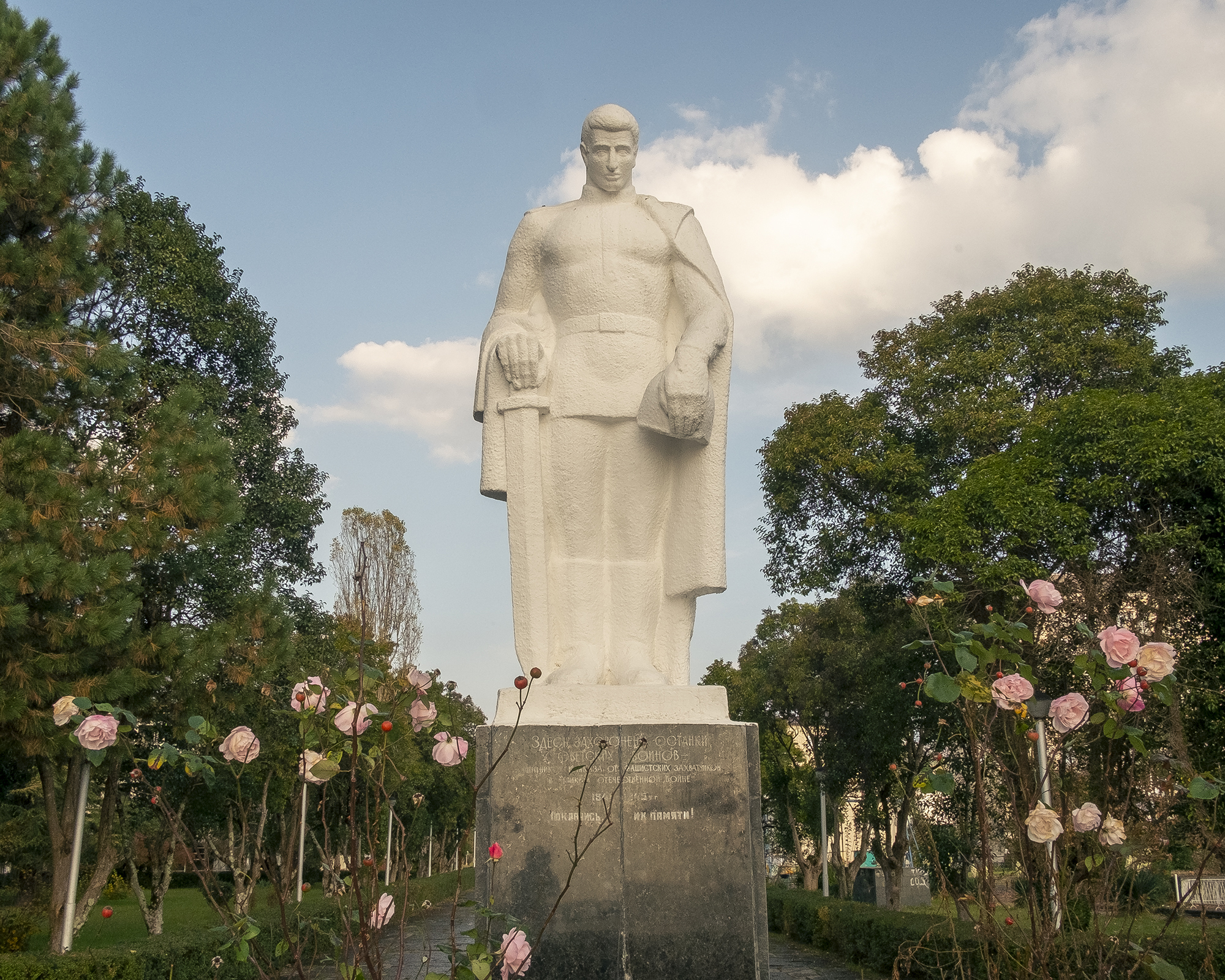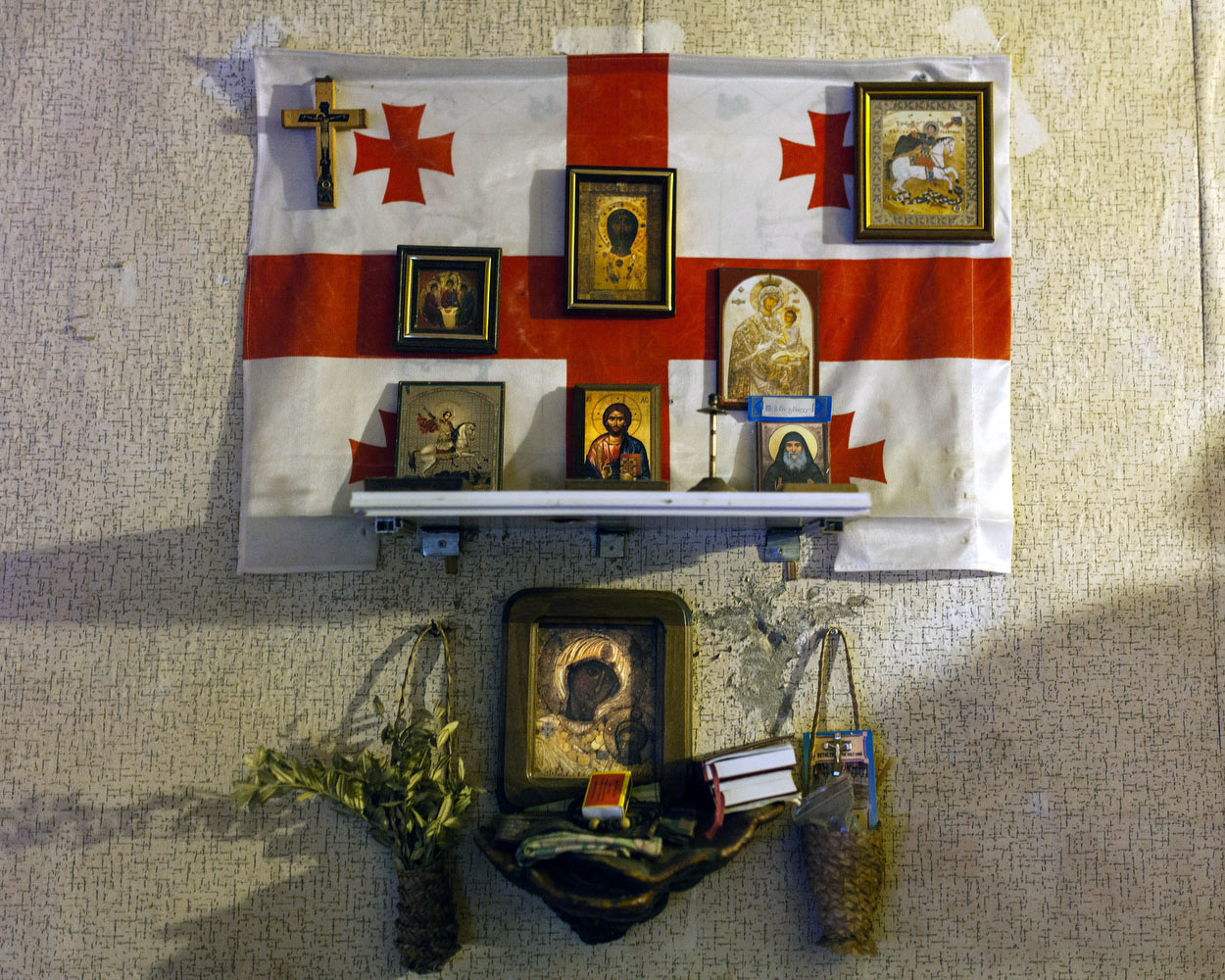Land
Of
Wolves
I:
მგლების მიწა
II:![]()
Ⅰ. St George slaying the Dragon, Freedom Square, Tbiilisi, 2014
ⅠⅠ. Dancer, Georgian National Ballet, Tbilisi, 2014
ⅠⅠⅠ. Tbilisi looking towards Mt. Kazbegi, 2014
The South Caucasus state of Georgia with its ancient capital city Tbilisi nestles between Western Asia and Eastern Europe.It has long been at the cross roads ofempires, religion and trade. The first unified kingdom of Georgia arose in the 11th & 12thCenturies.
The “Golden Period”which followed ended 200 years later when the country was subject to conquest and rule from the Persians in the east and Turks in the west. During this turbulent time the Georgians fought to hold onto their Orthodox identity, rich dialect and culture.The Persians named Georgia “Varkana” the land of wolves. Contemporary Georgia is a country of contradictions and dreams. It’s two hundred year relationship with its benefactor and protector Russia dissolved with the breakdown of the Soviet Union in 1991. Georgia,the jewel in the Sovietcrown,renowned for its food, music and culture, turned its back on its oldmaster. Its pursuit of independence has led to two brutal internal conflicts with Abkhazia and South Ossetia, Russian backed break away states that now lie within its borders.
Aaggressive neighbours, fragile infrastructure and political in fighting all stand in the way of the democratic ambitions of the fledglingr epublic.This series depicts Georgia at a turningpoint. A history of occupation and oppression has fuelled resurgence in Nationalism and celebrations of its cultural identity. The country is searching for its own way forward and the means to effect change whilst looking to the West for the security it believes EU and NATO membership will bring. Its desires have been driven by recent events inEastern Ukraine bringing back memories of the five-day war fought in 2008 where Russian troops pushed within 40km of Tbilisi. Once again Georgia finds itself at the brink, fearful of annexation.
To achieve its dream Georgia must confront it’s past and it’s present to secure its future.
The “Golden Period”which followed ended 200 years later when the country was subject to conquest and rule from the Persians in the east and Turks in the west. During this turbulent time the Georgians fought to hold onto their Orthodox identity, rich dialect and culture.The Persians named Georgia “Varkana” the land of wolves. Contemporary Georgia is a country of contradictions and dreams. It’s two hundred year relationship with its benefactor and protector Russia dissolved with the breakdown of the Soviet Union in 1991. Georgia,the jewel in the Sovietcrown,renowned for its food, music and culture, turned its back on its oldmaster. Its pursuit of independence has led to two brutal internal conflicts with Abkhazia and South Ossetia, Russian backed break away states that now lie within its borders.
Aaggressive neighbours, fragile infrastructure and political in fighting all stand in the way of the democratic ambitions of the fledglingr epublic.This series depicts Georgia at a turningpoint. A history of occupation and oppression has fuelled resurgence in Nationalism and celebrations of its cultural identity. The country is searching for its own way forward and the means to effect change whilst looking to the West for the security it believes EU and NATO membership will bring. Its desires have been driven by recent events inEastern Ukraine bringing back memories of the five-day war fought in 2008 where Russian troops pushed within 40km of Tbilisi. Once again Georgia finds itself at the brink, fearful of annexation.
To achieve its dream Georgia must confront it’s past and it’s present to secure its future.
IV:
IV: Vitali, an IDP & veteran of the Abkhazian War, stands in his small holding on the shores of the Tbilisi Sea. He fled his home in Gali, Abkhazia, nearly twenty years ago after Russian backed Abkhazian forces embarked on a campaign of ethnic cleansing against Georgians living in the town.
IV: Vitali, an IDP & veteran of the Abkhazian War, stands in his small holding on the shores of the Tbilisi Sea. Tibilisi Sea, 2014
V: A speaker at a pro EU, Pro NATO anti Russian rally in central Tbilisi. Tibilsi, 2014
VI: Megi & Ana two young Abkhazian IDP's (Internally Displaced People) stand outside the ex soviet hotel they call home. Tibilisi Sea, 2014
VII: Young Orthodox Georgians participate in a march in central Tbilisi to commemorate the Hundred Thousand Martyrs of Tbilisi. Tibilisi, 2014
VII:
VIII:
IX: Ex-president Mikheil Saakashvili speaks via video link from Kiev to a rally in Tbilisi. Saakashvili is infamous for his pro EU/NATO stance & anti Russian agenda during his time in power, leading to the 2008 five day war with Russia. His ex-party UNM is gaining support in the current domestic political sphere despite Saakashvili being unable to return to his native country for fear of arrest. He faces arrest for exceeding his official capacities in 2007.
IX:
X:
VIII: Ako Gogadze, a young political activist for the Georgian Conservative Party, stands guard at Tbilisi Airport as part of his National Service. Tibilisi, 2014IX: Ex-president Mikheil Saakashvili speaks via video link from Kiev to a rally in Tbilisi. Tibilsi, 2014
X: Girls in national dress prepare to practice traditional Georgian dances at the Georgian National Ballet in Tbilisi.. Tibilisi, 2014
XI: A Car parked outside an old dilapidated soviet era hotel which has housed a community of Abkhazian refugees since the 1990's. Tibilisi, 2014
XI:
XII:
XII: Nana, an Abkhazian IDP, stands by portraits of her sons in her apartment in Tbilisi. They both died in a car crash shortly after fleeing to Tbilisi after fighting with Georgian forces against Russian & Abkhazian troops in Sukhumi.
XIII:
XIV:
XV:
XV: Girls at an Orthodox rally in central Tbilisi. The Georgian Orthodox Church has around 3.6 million members out of a total population of 4.6 million. The church holds vast power and influence in a secular republic after decades of soviet rule.
XII: Nana, an Abkhazian IDP, stands by portraits of her sons in her apartment in Tbilisi. They both died in a car crash shortly after fleeing to Tbilisi after fighting against Abkhazian troops in Sukhumi. Tibilisi, 2014
XIII: Georgians protest at a large anti Russian rally in central Tbilisi. The overwhelming majority of Georgians are deeply suspicious and fearful of its neighbour after War between the countries in 2008. Tibilsi, 2014
XIV: Roland Abdushelishvili, an Activist and Miner, stands outside the Manganese plant in the Northern Town of Chiatura. 2014
XV: Girls at an Orthodox rally in central Tbilisi. The Georgian Orthodox Church has around 3.6 million members out of a total population of 4.6 million. Tibilisi, 2014
XVI: Lina sits with her Daughter Lola in the single room she shares in a dilapadated building with her children and husband in the up market "Vake" district of Tbilisi.
XVI:
XVII:
XVIII:
XVIII: European Union Monitoring Mission (EUMM) members patrolling the Georgian/South Ossetian boundary line. Georgia regards South Ossetia as sovereign territory. The region was the focus of the 2008 war with Russia and as part of the ceasefire brokered by Nicholas Sarkhozy Russia now has many peacekeepers patrolling the boundary, the EUMM ensure that the terms of the agreement are stuck to and assist in prisoner exchanges and mediation.
XIX: The boundary line between Georgia and South Ossetia; the government in Tbilisi still regards the break away region as sovereign Georgian soil. The Kremlin backs the defacto South Ossetian government and ethnic Ossetians living in the region hold Russian passports. The boundary line has divided entire communities and families, with many caught crossing the line detained by Russian peacekeepers.

XIX:
XX:
XVII: An active Manganese processing plant stands on the banks of the River Kvilira in the mining Town of Chiatura.Chiatura, 2014
XVIII: European Union Monitoring Mission (EUMM) members patrolling the Georgian/South Ossetian boundary line. Georgia regards South Ossetia as sovereign territory.
XIX: The boundary line between Georgia and South Ossetia; the government in Tbilisi still regards the break away region as sovereign Georgian soil.
XX: The State Minister of Georgia for Reconciliation and Civic Equality Mr Paata Zakareishvili. His role as Minister is to co-ordinate and monitor Georgian-Osettian & Georgian-Abkhazian relationships.
XVIII: European Union Monitoring Mission (EUMM) members patrolling the Georgian/South Ossetian boundary line. Georgia regards South Ossetia as sovereign territory.
XIX: The boundary line between Georgia and South Ossetia; the government in Tbilisi still regards the break away region as sovereign Georgian soil.
XX: The State Minister of Georgia for Reconciliation and Civic Equality Mr Paata Zakareishvili. His role as Minister is to co-ordinate and monitor Georgian-Osettian & Georgian-Abkhazian relationships.

XXII: Police stand on Rustaveli Avenue in central Tbilisi. In 2005 as part of the sweeping reforms brought in by ex president Mikheil Saakashvili the entire Transport Police along with many others were sacked due to endemic corruption. An entirely new police force was recruited. Many police stations were also rebuilt using glass to align with the new ethos of transparency and reform.
XXI: Monument to the fallen of the Great Patriotic War, Sukhumi
XXII: Police stand on Rustaveli Avenue in central Tbilisi. In 2005 as part of the sweeping reforms brought in by ex president Mikheil Saakashvili the entire Transport Police along with many others were sacked due to endemic corruption.
XXIII: Georgian Orthodox shrine in a government owned tenement in Tbilisi; many Georgians are Orthodox. With nearly 3.6 million members the Church vehemently opposes LGBT rights. In 2013 the head of the Georgian Orthodox Church called for the banning of a gay rights rally, describing homosexuality as an "anomaly and a disease." Some 30,000 protesters, including priests, attacked a pro gay rights rally, injuring 30.
 XXIII:
XXIII: